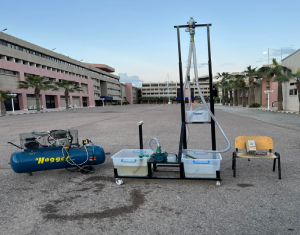Jet pump (air and water)
2022
Supervised by:
أ.د. السيد صابر
By:
Abstract
In order to understand jet pump and build a prototype, its principles had to be understood besides its advantages and disadvantages, how it performs by reading on studied graphs and data and last but not least its types and applications.
A jet pump is a mechanical machine. Its operation is based on Bernoulli’s principle, which states that an increase in the speed of a fluid is accompanied by a decrease in its pressure. A nozzle in the jet pump converts the pressurized, slow-moving power fluid into a fast-moving fluid. There are two inlets used to extract a constant flow of liquid. Pressure is used to produce such a suction lift. The mixture of the velocity and the inlet pressure of the fluids cause the medium to flow out of the pit, storage tank, or well through the pump up to the outlet point. Shallow well jet pump are suitable for reservoirs or wells with a total pump height of no more than 5.5 meters.
After a proper theoretical analysis, this project’s prototype will have a foundation to hold all of tools and equipment’s. A motor will draw water from a tank and directs it to the jet pump. Then, the jet pump will draw water from the other tank (which represents the well) through the suction section and out from the nozzle then drop into delivery tank. Testing the pressures, volumes and mass flow rate of the jet pump and tanks will be made.
Final Book Pdf Presentation
Keywords
Principle of Jet pump
Performance curves
Types and Applications
Two-phase flow

